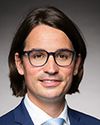Thank you, Mr. Chair.
I would like to thank the committee for inviting me.
It's a pleasure to be here. CHEO is the national capital's pediatric health and research centre. We have eight sites across Ottawa and the valley. Our main campus is about three miles from here. In fact, you can see the Peace Tower from the top floors of CHEO.
I would invite each and every one of you to come and visit. I'm happy to give you a tour some time.
If you came today, this is what you would see. You would see an emergency department that was rebuilt 10 years ago for 150 kids, which yesterday saw 213 and regularly sees nearly 300.
The longest length of stay in our emergency department yesterday was 32 hours. That is because we are running at an occupancy today of 105%, which means there are no beds, and so children wait in the emergency department with their parents until a bed is available.
September is on track to be the busiest September in the history of CHEO. CHEO is a 48-year-old organization. May, June and July of this year were the busiest May, June and July in the history of CHEO.
If you came today you would see kids transferred from far, far away because there are no beds in their community.
You would also see amazing people. You would see amazing, committed, passionate staff, physicians, volunteers, parents, caregivers showing grit, determination, compassion, delivering skilled expert care and battling through fatigue and frustration.
This is what you won't see today if you come to CHEO. You won't see the children whose surgery has been cancelled because we have no beds. We need to reallocate surgical beds for kids being admitted for respiratory viruses, including COVID.
You won't see the 1,000 to 1,500 kids who are referred this month and will be referred for diagnostic imaging, medical or surgical clinics, mental health care or rehabilitation care, the 1,000 to 1,500 per month who are above our capacity to see and who are being added to our wait-list. That's 12,000 to 18,000 being added to the wait-list this year.
You won't see the approximately 250 staff and physicians whose positions are vacant because of the mission critical health human resources challenges we face in Canada.
I recognize you could tell this story in almost any health care organization, hospital and other organizations across the country. Why should you care about it happening at CHEO? You should care because it's kids, because it's the future.
When a child has to wait for diagnosis for care or for therapy, they suffer. They suffer today and tomorrow, this year and next year. That's bad enough, but on top of that, it could affect and it will affect for many the entire trajectory of their lives.
As you would well understand, when a child is sick, when a child has a disability and is not getting the therapy they need, it's not just the child, but it is the whole family that is affected and often their parent's ability to engage in the workforce, or in broader society.
CHEO supports the work of Children's Healthcare Canada. We are a member of Children's Healthcare Canada. Children's Healthcare Canada, as you know, has called for a national child and youth health strategy backed up by meaningful federal investment, as words are not enough. I see Bruce Squires, the chair of the board of Children's Healthcare Canada, is here, and I am sure he will speak to it.
At CHEO we call this pedianomics. I know there is at least one economist on the committee. Pedianomics is the economics of investing in child health, the obvious return on investment of putting children on the path to lifelong health when they are tomorrow's innovators, taxpayers, caregivers and parents. Obviously, investing in children's health produces significant returns to our society. It also helps relieve pressure on the health care system.
In the broader health care system—what in the pediatric world we call the adult health care system—two dollars of every three dollars is on the management of chronic disease. Our health care system is a chronic disease system, and so the degree to which we can put children on the path to lifelong health and address from mental health to physical health, development, address their health issues and their developmental issues early, we will relieve pressure on the health care system later.
Our current circumstances are not caused by COVID. They are not caused by the pandemic. They have been accelerated and amplified by the pandemic. As you've heard from Dr. Doan, and as I'm sure you'll hear from the other presenters, the pandemic has had an outsized impact on the development, physical and mental health of children and youth. We owe them and we owe our country a singular focus on addressing those needs and putting them on the path to lifelong health.
Thank you for doing this study. Thank you for this opportunity. I look forward to the opportunity over the next two hours to have further engagement with you about it.




